Doom in the Tomb event is out for 2 weeks, and players are getting to play with some of the biggest staple cards that were out of Standard for a while already. After last expansion’s card buffs, players have wondered what Blizzard will prepare this time around. One thing is sure, the idea was innovative and really interesting – in theory, it’s a great way to spice up the meta. Normally, ~2 months after expansion’s launch is the most stale period. It’s been a while since new cards were introduced, we’re usually after a nerf patch too, and there’s still a month or so until next set’s announcement.
However, it’s not all roses. The overall reception of Doom in the Tomb event is very mixed. I feel like players enjoy the concept, but don’t necessarily agree with card choices. Indeed, my guess is that Blizzard wanted to make sure that the cards will be effective and change the meta, so they picked some of the strongest Wild cards available. So it’s not really a surprise that some of them started dominating the meta and quickly became some of the most popular cards on the ladder. In this article, I will showcase some of the main offenders and talk about their impact on Standard format.
Honorable Mentions
- Flamewaker – Before the event has started, Flamewaker was theorycrafted to be one of the more impactful cards from the event. And I do understand that sentiment – after all, Flamewaker used to carry Mage decks in the past, and the amount of cheap spells we have to combo with it is astonishing (Mana Cyclone builds of Mage were very popular this year, after all). However, players did not take the sorry state of Tempo Mage into account. Between nerf to Mana Wyrm and another rotation taking away a bunch of powerful tools, the deck didn’t really stand a chance against other powerful builds that also got improved. Trying to add it into existing Cyclone Mage builds was also pointless, because the deck has shown no promise after Conjurer's Calling and Luna's Pocket Galaxy nerfs. Overall, Flamewaker made Tempo Mage much more popular than it was before the event, but the deck’s win rate is… let’s just say that it isn’t on par with other meta decks.
- Swashburglar – If I had to pick #11 on the list, it would definitely be Swashburglar. It’s just a solid 1-drop, basically an auto-include in current Tempo Rogue lists, which was surprise to no one, because the card was auto-include back when it was still in Standard, and it was still an auto-include after it rotated out to Wild. Admittedly, Patches the Pirate was part of the reason for this card’s popularity, but a 1 mana 1/1 that cycles itself into something else is never a bad thing. While Tempo Rogue is still not very popular on the ladder (although it’s been getting some solid results lately in Legend), it was a very common tournament pick – e.g. 5 out of 8 best players from Masters Tour Bucharest have brought it.
10. Call of the Wild
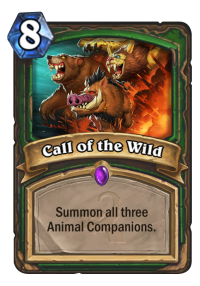
Did you know that Call of the Wild used to cost 8 mana? Yep, you could play it a turn earlier briefly after it was introduced. However, as Hunter started to dominate the meta back in One Night in Karazhan, the card was quickly nerfed to 9 mana. After a while, it has disappeared from the meta, only to come back when Spell Hunter was first introduced. While Spell Hunter is no longer viable (since the incentives to go full spell build have rotated out), the card has found its home in Highlander version. Not only it’s a solid standalone card (and those kind of cards are exactly what a Highlander decks wants to play), but it has amazing synergy with Zul'jin. Probably the main reason to run Zul’jin is re-creating a big board from nothing – and this card helps with that like nothing else. Just 2x Unleash the Beast + Call of the Wild summons five midrange minions, three of which can attack immediately – add a couple Secrets, maybe some Deadly Shot and you’ve got yourself a very powerful Zul’jin.
Call of the Wild didn’t shake up the meta in a major way, but it helped Highlander Hunter stay relevant. It used to be one of the stronger decks, but if it didn’t get anything while other decks got boosted… it might have fallen off heavily. While some, more aggressive builds don’t run it, it’s present in 90%+ of the decks (including most of the high win rate ones).
9. Lightbomb
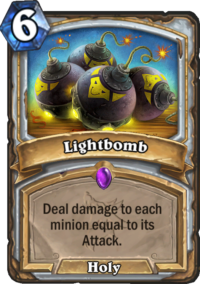
Priest and AoE removals go hand in hand – given the class’ heavy focus on Control & Combo archetypes, it’s rare that it’s viable without good board clears. However, the issue is that Priest’s Basic & Classic sets have none of those. Sure, there’s Holy Nova, but 2 AoE damage for 5 mana doesn’t cut it. There’s also Auchenai Soulpriest + Circle of Healing combo, and while not the worst thing ever, it costs 2 cards and still deals only 4 damage. That’s why unlike Mage, Warrior or Warlock, which can always fall back to Classic options, some of the strongest and most iconic Priest AoE cards were printed later in expansions. Lightbomb is one of them. Thanks to the card, Priest is now in a great spot when it comes to board clears – there’s Mass Hysteria, Lightbomb and Plague of Death, each one working well in different scenario.
Board clears are very important in this meta, especially in a deck like Resurrect Priest, which wants to stall until the late game and then dominate the board with big minion brought back to life again and again. It’s very effective in many matchups – very often it’s a full board clear for just 6 mana. And the best thing is that between all of your AoEs, you can often pick the best one for given situation.
8. Kun the Forgotten King
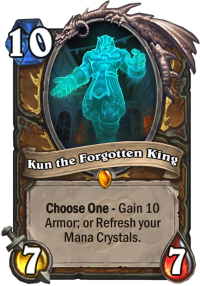
Kun was always an interesting card. Since it’s Choose One, it let players decide between a 0 mana 7/7 (but only after getting to 10 mana) or a 10 mana 7/7 that gains 10 Armor. It was mostly played as the former – in Ramp decks it was a big threat for free, and in Combo decks it was a way to cheat out other cards. How, you might ask? Aviana, back when she used to cost 9 mana, of course! You played Aviana, then 1 mana Kun to refill 10 mana, and then you could drop 1 mana minions, like Malygos. It was fun (well, not really if you were on the other side) until it lasted, but Kun is back in Standard.
But since Aviana is no longer available (and nerfed) and Ramp Druid was nerfed to the ground… why does it see so much play? The answer is simple – Untapped Potential. Quest Druid loves Kun, because not only you often get to 10 mana quicker thanks to Nourish, but Kun gets both options at once. In the late game, it’s essentially a 0 mana 7/7 that gives you 10 Armor, and the Armor part is really important given that Quest Druid tends to skip entire early game (making Kun a great way to catch up if you manage to survive long enough). Of course, Kun also activated some combos, just not with Aviana. If you draw it with Jepetto Joybuzz, you can refill 10 mana for just 1 mana, so you have 9 extra mana… to play Malygos, for example. Kun also combos really well with Flobbidinous Floop – the combo is not as impressive as with Jepetto, but it’s still 6 mana for free. You can even go for infinite Kun combo thanks to Baleful Banker and Elise the Enlightened – it’s not a staple, but a pretty popular tech, that comes in handy against those pesky N’Zoth decks.
7. & 6. Mysterious Challenger & Avenge
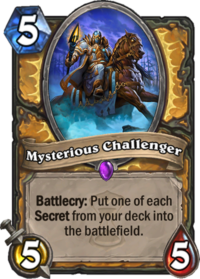
I’ve combined those two cards together, because I’ve never seen them being played apart. I guess that Avenge could be used in an Aggro Paladin deck without the entire Secret package, but I don’t believe that such a deck exists. Mysterious Challenger is one of the most notorious Hearthstone cards ever printed, although in a hindsight I do think that it’s being slightly overrated. Secret Paladin was one of the strongest decks in the history of Hearthstone, that’s true, but Mysterious Challenger was only one of the reasons. The deck’s power came from it’s crazy curve- it had the best 1-drop, best 2-drop, best 3-drop etc. in the game, so if it drew right (and by right I mean 1-2-3-4 etc.) it could overwhelm most of the decks. After lots of those powerful drops have rotated out, however, Mysterious Challenger was in Standard for another year and it has only seen some niche play. Even in Wild, it was only briefly popular and never really the strongest deck.
However, I need to give the credit where it’s due – Challenger is a powerful card in the right deck. Pulling out usually around 4 mana worth of cards from your deck and playing it immediately ON TOP of an already solid 6/6 body creates a massive tempo push. You want to kill it? Nope, it revives. You want to AoE the board? Nope, it gets buffed with +2 Health. You want to attack face? Nope, you get blocked by a 2/1. That’s the thing about Mysterious Challenger – it creates those awkward to answer board states, where opponents might have to spend an entire turn just trying to tack through all the Secrets.
And Avenge… It’s probably the single strongest Secret ever printed. 1 mana for a +3/+2 buff is huge. Normally it would cost around 3 mana, so when it’s triggered, it gives you 2 mana worth of tempo for free. Of course, it comes with downsides – you can’t time it, opponent can somewhat control what it lands on, it doesn’t trigger when you have only a single minion on the board and so on. But still, if you put your opponent in a situation where he has to trigger it (which is common with a pretty aggressive Paladin builds), it can help you snowball the early game.
Both of those cards see common play in Highlander Paladin – a deck that was already getting some attention before the event. Right now it’s one of the better builds on the ladder. And when you get lucky with the draws (which is not super consistent given that it’s Highlander, but happnes), it feels a bit like the Secret Paladin of old.
5. Ragnaros the Firelord
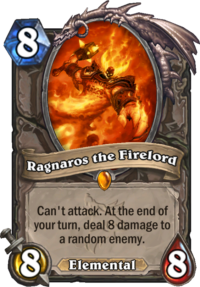
Ragnaros used to be a Classic card, then it was part of the first Hall of Fame rotation over 2.5 years ago. And now it’s back. You can imagine the reason why Blizzard has decided to rotate it out – the card was omnipresent. It was an auto-include in any Midrange and Control deck, even some slower Aggro builds played it as a finisher. But what’s so good about it? 8 mana 8/8 with RNG damage doesn’t seem that amazing, but in reality, it’s one of the best late game threats ever printed. The fact that it shoots fireballs instead of attacking like any other minion means two things. First of all, it deals damage right away. You often play him in the situation in which it either clears a midrange/big minion or it hits face for 8. While clearing minion is usually a better outcome, 8 face damage is very strong too in lots of matchups. The second reason why it’s so good is that while normal minions take damage to trade, Ragnaros doesn’t. If you put it behind a Taunt, it will deal 8 damage to something every turn no matter what. Opponent has an 8/8? Sure, it can clear it without dying – a normal minion would have to sacrifice itself. Talking about Taunts, the damage can also notably ignore Taunts, so if you got your opponent down to 8 (or less) and the he Taunted up, a lucky Rag shot could still finish the game. Nearly every YouTube Hearthstone clip compilation had some Rag moments, because it was a card that kept on giving.
Now, it’s only natural that Rag started seeing A LOT of play after it’s back in Standard. Despite Shaman being the most popular class (and it’s a board flood class), Rag is still a very strong play, being used in nearly 25% of decks. Highlander builds are its most popular destination – Hunter, Mage and Paladin alike run Rag in different builds. It’s also a very strong card in Resurrect Priest and one of the easiest way to win games. If you get him into your Resurrect pool and then keep reviving it, you can kill your opponent without ever having to attack him. It would probably see even more play if not for the fact that ~30% of the meta are decks against which Rag is not the best play (because it often snipes some random 1/1 or Totem instead of doing anything meaningful). Still, it’s a great and very impactful card.
4. Sylvanas Windrunner
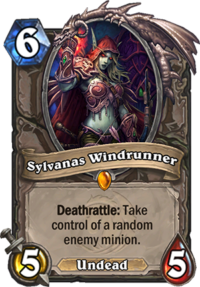
Did you know that Sylvanas Windrunner not only used to be a Classic card, but also costed only 5 mana back in the day? Of course, it quickly became an absolute auto-include (nearly every deck played her), so she was nerfed to 6. It still wasn’t enough, and just like Ragnaros, she was a part of the first Hall of Fame rotation. And she’s back. I think that it was a rather weird decision to bring back both her and N’Zoth in the same event, because of the massive synergy between those two. Having one Sylvanas is good, having the ability to add her to the N’Zoth’s revive pool is even better. As it turned out, it’s not really Sylvanas that broke N’Zoth, but later about that.
I’ve always said that the main reason why Sylvanas Windrunner is so good is that she’s awkward to play around. Of course, not so much when played on the empty board, or when your opponent can just trade it cleanly, but very often it’s just impossible to play around well. Let’s say that you drop it into a board with a few minions. If your opponent can’t Silence/Transform it (which is often the case, neither of those are particularly common right now), he can either ignore it and develop more or trade and risk stealing their best minion. In the first scenario, not only you can get some good trades, but possibly even control what you’re going to steal. In the second scenario, Sylvanas gets much more value than a regular minion would, especially if you get lucky enough to steal biggest thing from the other side.
Of course, the card is not perfect – it’s slow (the moment you drop it it’s just a 6 mana 5/5 with no immediate impact), it’s random and it doesn’t work very well against boards flooded with small minions (stealing some 1/1 or 2/2 is not amazing), but it does a remarkable job against slower builds. Because of that, she’s nearly an auto-include for N’Zoth decks (both because of the synergy and because she fits into slower decks), but even some non-N’Zoth Highlander Paladins or Warriors decided to include her.
3. Emperor Thaurissan
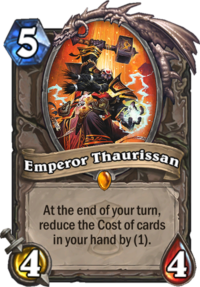
If I had to pick my favorite Hearthstone card ever, it would be Emperor Thaurissan. I’m a sucker for Combo decks, and the time when Thaurissan was in Standard was the era of combos. We had many broken combos that costed 13, 14 or maybe 15 mana – normally they would be unplayable, because if you can’t drop the entire thing in a single turn, your opponent would disrupt it. But Thaurissan allowed players to have those expensive combos and still play all of the cards at the same time. Malygos combos, Prophet Velen combos, Archmage Antonidas combos, Leeroy Jenkins combos and so on and so on – the number of deck it activated over its time in Standard is massive.
In the current format, however, Thaurissan is no longer as broken as it used to be back in some previous metas. A lot of the powerful combo cards have rotated out. Priest’s Mind Blast would be the best example – with Thaurissan back in Standard, Priest could easily go for 28 damage burst with Velen + 2x Mind Blast + 2x Holy Smite. Or even better, 34 damage with Malygos and the same combo. I remember playing the deck a lot back in the day, but right not it’s not possible. On the other hand, Charge-based combos built around Leeroy are blocked by all of the Taunts like Zilliax or Khartut Defender.
Of course, it doesn’t mean that Thaurissan is a bad card, oh no. It’s the second most popular Legendary on ladder, after Zilliax. It’s played in a bunch of different decks – mostly Control, but we have some Combo builds too. N’Zoth decks run it simply to discount their expensive plays – especially against faster builds, getting N’Zoth out a turn earlier can be a difference between winning and losing. It also activates some cheeky plays, like N’Zoth + Seance in Priest, Togwaggle's Scheme in Rogue (although this one can be handled by Shadowstep too) or even N’Zoth + Brewmaster in Control Warrior (in the mirrors, you can even use it to bounce back Elysiana like during the *cough* “good old days”). The card is also very useful in Mage – Tempo version can use it to discount Flamewaker(s) and a bunch of already cheap spells to deal massive amounts of damage in a single turn. Slower builds, like Highlander, can discount Archmage Antonidas and – again – some spells to get more Fireballs than they normally would. Combo decks like Malygos Druid or Holy Wrath Paladin also benefit from the discount, although not as much as to dominate the meta or activate some crazy combos that weren’t available before.
2. Evolve
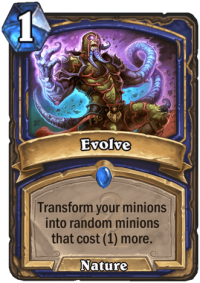
The second most notorious card from Doom in the Tomb event is Evolve. One could argue that it should be #1 – after all, Shaman is dominating the meta. Between Quest and pure Evolve / Aggro (depending on how you classify it) versions, it’s ~30% of the current meta at higher ranks. That’s A LOT, especially given how homogeneous those decks are (they don’t always feel like completely different archetypes). I would say that its impact on the meta was not THAT big. Shaman was already ~20% of the meta before the event has started. Quest Shaman was #1 when it comes to popularity and one of the strongest decks. So while Evolve did improve it even further, it wasn’t a 180 degrees turn – from a bad deck to a Tier 1 one.
But of course, Evolve made a big difference. Shaman decks were already running Mogu Fleshshaper + Mutate combo – after all, you could often remove a small minion and then transform it into a random 8-drop… all for 0 mana. Even if you just paid 3-4 mana, it was still an insane tempo play. Evolve not only added another way to turn it into a 4-drop, but synergizes with other cards as well. The best synergy is obviously Desert Hare – it’s a bit similar to the oldschool Doppelgangster + Evolve combo. It’s 4 mana for 3x random 4-drop or 6 mana for 3x random 6-drop – I’d say that the plays were similar in terms of power level. But we didn’t have Fleshshaper back then, which just adds to the overall power. Another consideration are – obviously – Lackeys. Shaman decks often end up flooding board with those, and they’re just 1/1. Turning them into some 2/3’s or 3/2’s is a big improvement, which can change a small and nearly harmless board into a lethal threat.
Evolve was a card that should not be a part of this event, in my opinion. Maybe they’ve underestimated the card’s power (although I doubt that, since it was a very strong card back when it was in Standard), or made the list of cards BEFORE Shaman became a dominating force in the meta without any more help, but they should still reconsider it. Giving an already arguably best deck another powerful tool was not the best idea, and if nothing will happen, we’ll see ~1.5 more months of Shamanstone. Of course, the meta might still adjust itself over time, people might find some great counters, but I still doubt that Shaman is going to disappear.
1. N’Zoth, the Corruptor

Yep, #1 is very clear in my opinion – it’s N’Zoth. While Evolve only improved already strong decks, N’Zoth changed the meta completely. Not only it activated a bunch of less popular / off-meta builds (imagine someone playing a slow Rogue build full of Taunts a few weeks ago), but it brought back one of the most notorious decks in the history of Hearthstone – Resurrect Priest. While it was known under a few different names (Big Priest, Wall Priest), the idea was always the same – to get out some big minions and then keep reviving them. Given that the minions you wanted to bring back more or less lined up with those that would be brought by N’Zoth (not to mention that you could also throw in Sylvanas), it was a natural choice for this deck, giving another way to flood the board with lots of minions (and often just seal the game on spot).
However, I would say that the main reason why N’Zoth is so good is the fact that Saviors of Uldum has introduced Khartut Defender. Those two have INSANE synergy, and anyone playing Wild could attest to that. Despite the fact that Wild decks running N’Zoth are already packed with powerful cards, they found enough space for Khartut Defender. The reason is that thanks to Reborn, after one Khartut fully dies (both parts of it), you’re getting two of them into revive pool. And two Khartuts means four Taunts + 12 points of healing. That alone would make N’Zoth a solid card (because 5/7 + 2x good 6-drop for 10 mana is already not a bad deal). Throw in a few more good Deathrattle cards into this pool and… it turns out that nearly every slow deck has a good reason to play N’Zoth now. That’s because you don’t have to build an entire deck around it – you can play a 5 card package (with notably the individual Deathrattle cards also being solid) and add another win condition to your deck.
Because of that, N’Zoth is one of the most popular Legendaries on the ladder. Last time I’ve checked, it was 26% of the ladder from R10 to Legend. Given that Shaman is ~30%, it means that N’Zoth decks + Shaman make up for over 55% of the ladder. Pretty crazy, huh? And also pretty tiring if you ask me. N’Zoth decks are fun to play as, but not really fun to play against. Especially when you stumble upon N’Zoth mirrors – oh boy, those matches can drag out. Now play N’Zoth Rogue mirror where both shuffle 15+ N’Zoths into their decks… Yeah. I’ve tried the deck and the moment I’ve stumbled upon a mirror matchup I just conceded, because I figured out that I will finish 3-4 matches in the same time. I think that N’Zoth is a too high power level card to bring back in event like that – it was obvious that it will become a big part of the meta (even before Sylvanas was announced to come back too).
Summary
The list is over, so I’ll cut it here with a quick summar. I love the idea behind this event, but I don’t think that the cards were chosen correctly. The last few cards probably already illustrate my point quite well. We shouldn’t get those powerful, staple Neutral Legendaries, because when everyone plays them, they are no longer interesting – they become annoying. No matter how “fun” the card is, when you face it all the time, it becomes old very quickly. We also should not get cards that improve already powerful existing archetypes. Evolve is the biggest offender here – even if Quest Shaman wouldn’t get it, it would still be a solid deck, so the slot was wasted in my opinion.
Instead, what we should see are cards that improve T3-T4 archetypes and decreases the gap between them and the currently best decks. For example, I think that Paladin’s picks were amazing – we’ve got Secret Paladin back and it’s working, but it’s not overpowered. It has the power to compete with other Tier 1 decks, but didn’t become the unquestionable #1 deck that’s all over the ladder. Instead of Evolve, I would like to see another card that improves the Midrange / Totem Shaman approach – for example Thunder Bluff Valiant. Maybe between it and Thing from Below, Midrange/Totem Shaman would become somewhat viable (they would have to test it internally first, but it’s just an example). Of course, that kind of approach would be much harder to balance – if you miss in terms of power level, it can turn out that none of the cards brought back see any serious play. That’s why Blizzard has decided to play it safe and bring back cards that will SURELY see play… which is also a wrong approach, because we end up in situations like the one we have now.

[…] Article: Most Impactful Doom in the Tomb Wild Event Cards […]
My guess is they tested if a modern version between Wild and Standard was already viable…
Not yet anyway..
I do think that HS will need more formats in the future. For a lot of people, Standard is boring because there aren’t enough cards available, or they don’t like that it changes to quickly. On the other hand, Wild will only get wilder as the time goes by – few years from now everyone will run some completely broken strategies. So we might eventually need something like extended Standard (which has let’s say 4 years worth of sets and not 2), or maybe a rotating format that takes a few years worth of sets and puts them together, then changes every year for a completely different compilation of expansions. Or… something. They’re better game designers than I am, I’m sure they can figure something out.
Here’s an idea, I guess its time that most of 10-mana minions archetype gets a buff such as immunity from targeted spells. This would stop most of them to be overused. (Like copies of minions, etc).
And prevent them to be Hexed (because I think most of 10-mana minions is quite powerful to be able to get hexed by any spells).
Facing a Rogue with 10+ N’Zoth shuffled into the deck is definitely not fun anymore.
That’s not a bad idea but the problem is it can be heavily exploited. Just imagine Shamans evolving their high-drops into a guaranteed big 10-mana Hexproof minion, or Zoo-like archetypes being able to play a Sea Giant with Hexproof and pretty much winning on the spot.
that’s why i say just most of them, not all. maybe Old Gods 10-mana minions, Dragons, etc.
and, besides, that’s not how exploited if you can only do it once or twice.
(Giants can’t be evolved, or rather, it stays as Giants, I’ve seen it.)
plus, you dont wanna leave those big minions on board for long.
I mean, thats not how exploited works, if you can only use it once or twice.
Unlike Rogue who can use N’Zoth Battlecry 10+ times.
I don’t know other class who can exploited Battlecry like this.
I think putting back Ragnaros and Sylvanas was fine. They’re powerful, but not as powerful as back in the day. Evolve would be fine if Desert Hare wasn’t around. Thaurissan… Mixed feelings. I love that it enables all sorts of combos. But yes it feels very hopeless to be on the other end. N’Zoth was obviously a mistake, especially with Kartut Defender in Standard. It reminds me of the flooding of Void Daddys that Bloodreaver Gul’dan brought back when played, and now it’s available to every class.
Agree with pretty much everything you’ve said here. Great article as per usual.
Evolve was clearly a mistake and one I hope Blizzard resolve ASAP.
I was really excited about playing N’Zoth again, he’s always been one of my fav cards. However Kahtut defender makes him miserable to play against. Without that card N’Zoth would be fine.
I do have a feeling that Blizzard are using this as a it of a test and we’ll see more in the future (maybe once a year) The power level differences in the cards chosen is massive. Hopefully next time warlock gets some love. *cough Rin Cough*
Totally agree with the previous 2 comments. The intention of bringing back these wild cards is to refresh the SoU meta. It has indeed shifted the meta drastically but ironically made the current meta staler than ever before.
It just literally makes no sense to bring back old very problematic cards. There is a reason why Rag and Sylvanas were hall of famed. But in the current metagame it still feels like the decision can be backed up, they are not destroying you completely just on impact.
But Nzoth and Emperor are just everything that blizzard claims to not want in their game. They should have learned from their DK powerlevel mistake, that Nzoth powerlevel cards are just not fun… Especially when cards like Seance etc exist so you can even play the card several times.
And Emperor is just a horrible card because it allows too many ridiculously broken plays that blizzard will not balance around. That card reads OTK all over it, which blizzard, again, CLAIMS, that they dont want in the game.
It worked nicely, or at least decently, the time they buffed the class cards, but bringing overpowered/very problematic NEUTRAL legendaries back in the game, is just a horrible decision.
“Evolve was a card that should not be a part of this event…” absolutely agree. Shaman is one of my favorite classes, and Token Shaman on Saviors of Uldum was a deck which I really enjoyed and liked playing it, but I stopped playing it once the event came out as that deck (card) feels really unfair and too powerful so early in the game.